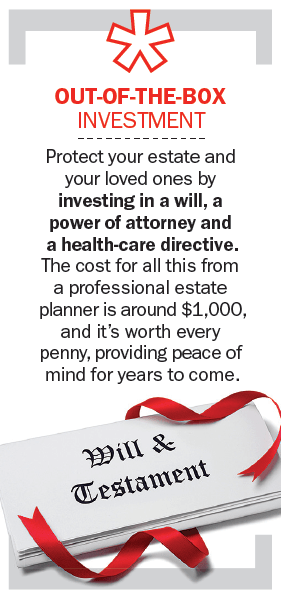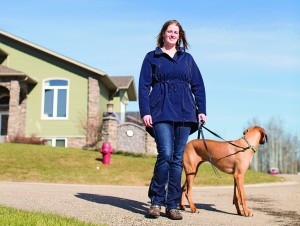Where to invest $1,000 now
Want the best possible return? We'll take you through the most rewarding options, no matter how much you have in your pocket
Advertisement
Want the best possible return? We'll take you through the most rewarding options, no matter how much you have in your pocket

So you’ve suddenly got $1,000 burning a hole in your wallet but you aren’t sure what to do with it—all you know is you want that money to grow. Chances are you recently finished school and, armed with a degree, you’re now working diligently at establishing a career. For the first time, you’ve got a steady stream of income coming in and you’d like to start investing, hopefully for the biggest possible return.
Tegan Alce certainly understands that feeling. Since graduating from veterinary school in April 2014, the 27-year-old Victoria native has been pursuing her passion for animal orthopedics in Dawson Creek, a small agricultural city in northeastern B.C., while working equally hard at eliminating her student loans. Her discipline has paid off. Alce is now completely debt-free and has a new goal: home ownership. The problem is she’s not sure what type of investments are appropriate for her, or whether she should use an RRSP or a TFSA. “My short-term goal is saving enough for an $80,000 down payment,” say Alce. “However, I’m also interested in finding out more information on diversifying my portfolio to cater towards long-term growth.”
If, like Alce, you’re anxious to start growing your wealth but aren’t sure how to get the ball rolling, read on. The following tips will help you get the most out of your first grand and lay the foundation for habits that will keep you motivated over a lifetime.
Although it may not seem like it, Alce’s decision to focus on paying off debt was her first smart investing decision. For young people with modest amounts of money to invest, debt reduction and interest avoidance provide a guaranteed return that any investment would be hard-pressed to beat, says Jason Heath, a fee-only Certified Financial Planner at Objective Financial Partners in Toronto. This means nobody should be looking for a place to invest their first $1,000 if they’re spending more than they earn, or if they have high-interest debt.
A great way to keep on top of any future debt, particularly unexpected credit-card charges, is to have some money stashed away for emergencies like a job loss. “Having a couple of months of income set aside in savings is a good starting point,” says Heath.
» Where to invest $100,000 now
Now that you’ve squared away any debt and you have an emergency fund, you’re in great shape to start investing—but not until you’ve figured out what your goal is. “You’ve got to ask yourself, ‘What is this money for?’” says Marc Lamontagne, a certified financial planner with Ryan Lamontagne Inc., in Ottawa. “Is this money you might use in a couple of years? That would mean keeping it safe or liquid. Or is it for something you’re putting aside for retirement? In those cases, you can put it in something riskier or longer term like equities.”

Alce’s goal is home ownership, so she’ll need to have access to her money within a few years. For short-term savings goals, it often makes sense to use a Tax-Free Savings Account (TFSA), which allows you to save and invest without paying any tax on the growth when you make withdrawals. But if your investment goal is long term, consider an RRSP. Like TFSAs, contributions placed in an RRSP grow tax-free. Unlike TFSAs, however, taxes on contributions are deferred, so you can deposit more up front (as long as you reinvest those refunds) and you won’t have to pay tax on that income until you start drawing down your savings in retirement. When you’re young and starting to save, RRSPs don’t offer a huge advantage over TFSAs, but as you move into middle age and your income goes up, RRSPs will offer a larger and larger advantage.
In Alce’s case, Lamontagne says she should consider using an RRSP to save for both her retirement as well as for the down payment on her home. As someone working in a specialized field, she’s already earning a substantial income, so saving for her home in an RRSP and then withdrawing the money for her down payment through the Home Buyers’ Plan (HBP) will get her to her savings goal faster. The HBP program allows first-time home buyers to withdraw up to $25,000 from their RRSP to put towards a down payment (if you’re a couple, the combined tax-free withdrawal amount increases to $50,000).
Because of her high income, Alce will get a big tax return from her RRSP contributions, which she could then reinvest in her RRSP. Once Alce reaches $25,000, she can start saving for her home in a TFSA. The only catch with the HBP is that Alce will have to the pay the money back within 15 years, starting the second year after the money was withdrawn.
» Where to invest $500,000 now
Anyone new to investing should be fairly conservative with their investments until they have a better understanding of how the markets work, says Lamontagne. “If something adverse happens, it might dissuade them from investing over the long term. At that age you can’t afford to lose that much money.”
Heath agrees, adding that “the likelihood you’ll need it soon is quite great.” More often than not, young people are saving for a car, or a home down payment, or a maternity leave—“extraordinary expenses that happen between 18 and 35.”
If you need to keep your savings liquid but are hoping to earn a bit of a return, Heath suggests forgetting about high interest savings accounts (which don’t even keep up with inflation) or guaranteed investment certificates, (which lock in your money but offer interest rates similar to money market accounts). Instead, he says to consider a short-term bond fund.
One fund that I think fits the bill is the Canadian Short-Term Corporate Bond Index ETF (VSC), which tracks the Barclays Global Aggregate Canadian Credit 1–5 Year Float Adjusted Bond Index. It’s currently yielding about 1.5% per year, compared to 1% for savings accounts and short-term GICs.
If your investment horizon is long term and you’re able to invest more aggressively, you should consider starting out with mutual funds. Despite their reputation for high fees, they can be a great choice for those with small accounts. That’s because even a fairly high percentage fee translates into a small cash amount when you’re getting started. Given the amount you’ll be paying in fees for an account of $10,000 or less, there simply aren’t many other options out there.
Still, you should keep your fees as low as possible. For mutual fund newbies, Lamontagne recommends using one of Tangerine’s four basic index fund options—they range from conservative to aggressive, depending on your risk tolerance and timeline for investing. Take the Tangerine Balanced Growth Portfolio, which invests primarily in Canadian, U.S. and international equities, with some exposure to Canadian bonds. Its 10-year annualized return is 5.55%, which is about what you should expect from a portfolio designed for long-term growth. Best of all, “with fees of only 1.07%, you’re paying half of the average Canadian mutual fund fee and there’s no minimum investment,” says Heath.
Never make the mistake of being so concerned with finding the perfect investments that you ignore the importance of saving.
One of the most effective ways to build up your RRSP or TFSA is to set up automatic biweekly or monthly contributions based on a percentage of your paycheque, something manageable like 10%. You may feel a sting when you see your first reduced paycheque, but within a month or two you’ll barely miss it. Don’t forget to explore automatic payment options at your workplace as well. Visit your human resources department to see if there are any RRSP plans that offer discounted management fees, or better yet, matching contributions from your employer.
By following these tips, Alce—or any young investor—can expect her first thousand-dollar investment to grow to $10,000 quickly, provided she has the discipline to stay invested. Don’t believe me? Let’s say that you earn a net after-tax income of $30,000 and you invest $1,000 in the Tangerine Balanced Growth Portfolio, then continue to automatically deposit 10% of your paycheque into the fund every two weeks. After just three years, you will have more than $10,000 in your account and you’ll be ready to move onto the next section. By that time, your investment savvy will have increased and some new investing options will open up to you as well.
Out of school, in the job market, earning regular income and want to start investing? Here’s how to get a better return on your first grand
1. Saving up for a wedding, car or home down payment? You’ll need to keep that money safe and easily accessible, meaning aggressive investing strategies aren’t appropriate. These days GICs and high-interest savings account don’t offer much value. A better choice is a short-term bond index fund, such as the Canadian Short-Term Corporate Bond Index ETF (VSC).
2. For longer-term savings, consider a single, low-cost balanced index fund, such as the Tangerine Balanced Growth Portfolio fund. With fees of only 1.07%, you’re paying half of the average Canadian mutual fund fee and there’s no minimum investment.
3. Another option for longer-term investors are so-called “robo-advisers.” These are online services that design, implement and manage low-cost ETFs portfolios for a fraction of the cost of traditional “human advisers.” Wealthsimple, for instance, has a minimum account size of $5,000, and charges management fees of 0.5% per year (plus embedded ETF fees of about 0.25%) on portfolios of $5,000 to $250,000.

Saving up for a house of dreams
When Tegan Alce finished veterinary school last year and began working, she wisely decided to focus on paying down her student loans first. With that debt now eliminated, she’s in great shape to start saving for the dream home she hopes to buy within the next few years. Because Alce will need the money soon, our experts recommend she stash her savings in a short-term Canadian bond ETF, or, if she’s comfortable taking some risk, in the Tangerine Balanced Income Portfolio. While TFSAs are generally best for short-term saving, certified financial planner Marc Lamontagne says that becauase she already has a relatively high income, Alce could save inside her RRSP and use the Home Buyers’ Plan to withdraw up to $25,000 for her down payment.
Visit MoneySenseWeek.ca for more great money tips »
Share this article Share on Facebook Share on Twitter Share on Linkedin Share on Reddit Share on Email